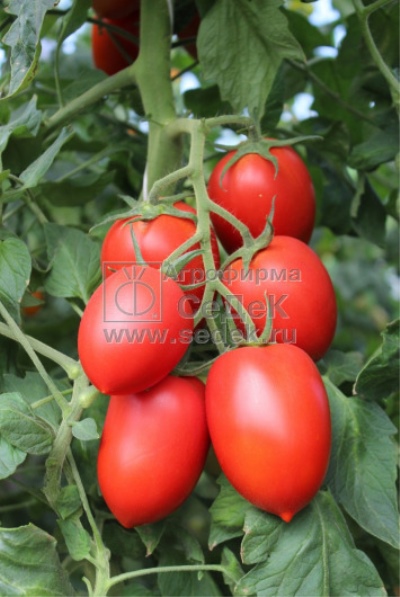
- Authors: Lukyanenko A.N., Dubinin S.V., Dubinina I.N., Agrofirma SEDEK LLC
- Year of approval: 2011
- Category: hybrid
- Growth type: indeterminate
- Appointment: fresh consumption, for whole fruit preservation
- Ripening period: mid-early
- Ripening time, days: 95-100
- Growing conditions: for film greenhouses
- Marketability: excellent
- Transportability: Yes
Empire is a hybrid tomato variety bred by breeders of Agrofirma SEDEK LLC and approved for use in 2011. Growing these tomatoes from seeds is not easy, but if a patient gardener succeeds, he will be rewarded with an excellent harvest.
Description of the variety
The bush is tall, its height reaches 200 cm, some stems can grow up to 2.5 m in length. Shoots are densely covered with large, dark green leaves. The flowers are simple. The first inflorescence is formed above the 7-8 node, the subsequent ones grow after 2-3 leaves.
The main qualities of the fruit
When unripe, tomatoes are light green in color, ripe fruits are orange. The weight of each is 90-140 g, the shape is slightly ribbed, obovate. One brush forms 6-8 tomatoes at once. Their main advantage is their excellent presentation and transportability. The firm pulp allows you to keep the fruits unchanged for up to one and a half months.
Taste characteristics
Judging by the reviews of summer residents, Imperia tomatoes have an excellent taste. Their juiciness is clearly expressed in fresh lettuce, but nevertheless, these tomatoes are highly appreciated when whole-fruit canning, and especially when dried.
Ripening and fruiting
Empire belongs to the varieties with a medium early ripening period. The first tomatoes appear 95-100 days after the first shoots. The variety is characterized by long-term fruiting.
Yield
The variety is considered a high-yielding variety: from 1 m2 it allows you to harvest up to 9.0 kg of fruit.
The timing of planting seedlings and planting in the ground
The presented species belongs to hybrids, and therefore it is not able to give several generations of plants at once. This means that new seeds need to be purchased every year. Before planting, it is recommended to hold the planting material in a solution of potassium permanganate.
Sowing is carried out in 1-2 ten days of March. It is better to prepare a separate container for each seed, this will facilitate the picking process, even allow you to skip it. If it was not possible to avoid a pick, then this should be done when two leaves appear. Optimal daylight hours for seedlings should be at least 13 hours.
A transplant to a summer cottage is carried out 55-60 days after the start of sowing. The usual plant for this day has a length of 25 cm.

Growing tomato seedlings is an extremely important process, because it largely depends on whether the gardener will be able to harvest at all. All aspects must be taken into account, from seedbed preparation to planting in the ground.
Landing scheme
Prepare the soil before transplanting. To do this, mix the earth with humus and treat with a pest control. Planting scheme - up to 6 bushes per 1 m2.

Growing and care
It is allowed to grow the presented variety only in a film greenhouse. The culture requires binding to the trellis and forming a maximum of two stems. Grasshopping should be carried out within 10 days after transplanting into the greenhouse, otherwise the plant will direct all its forces to the development of stems, and not to the formation of fruits.
To make the tomatoes feel comfortable, observe the temperature regime of +24 degrees and humidity of 70%. Be sure to ventilate the greenhouse and maintain adequate light. Water the bushes twice a week, do not forget about weeding and loosening.




A plant needs different micronutrients at each stage of growth. All fertilizers can be divided into two groups: mineral and organic. Folk remedies are often used: iodine, yeast, bird droppings, eggshells.
It is important to observe the rate and period of feeding. This also applies to folk remedies and organic fertilizers.
Disease and pest resistance
The Imperia variety has a high immunity to such ailments as alternaria, verticillosis, tobacco mosaic virus, but the plant can be affected by late blight. For prophylaxis, periodic treatment with special formulations is required. To prevent the development of fungus, ventilate the greenhouse and avoid waterlogging the soil.
Inspect crop stems and leaves regularly for insects. Beetles and their larvae can be collected by hand and destroyed, or a special trap can be prepared.
Reviews
According to the experience of gardeners, the hybrid does not germinate well. And also of the minuses, there is a too dense skin, which reduces the pleasure of eating tomatoes. There are more advantages: this is unpretentiousness to growing conditions, and an early ripening period, and the excellent taste of tomatoes, especially in dried form, and their long-term keeping quality.



























































































